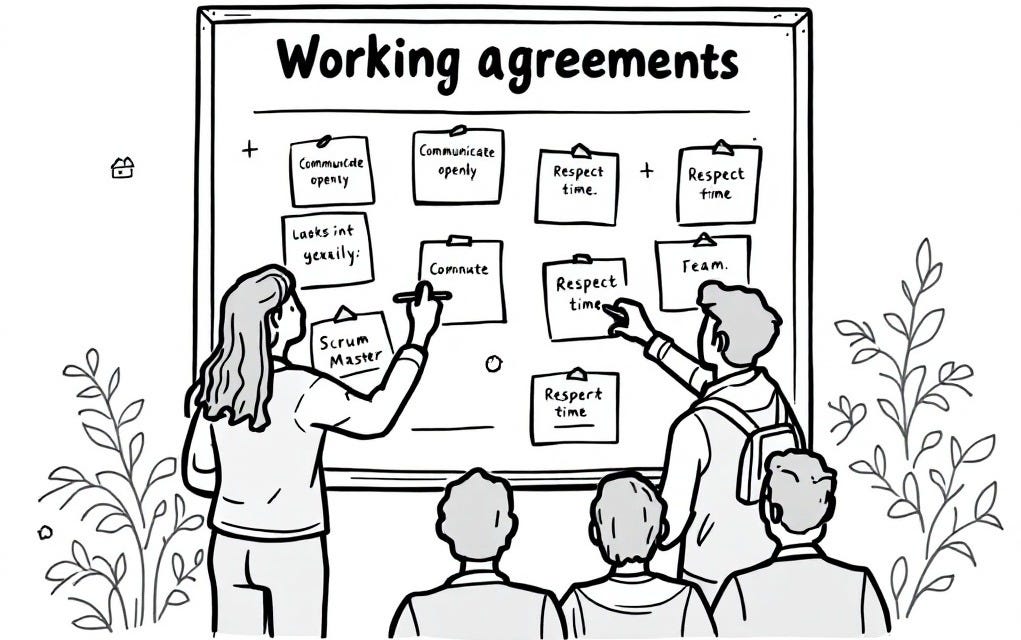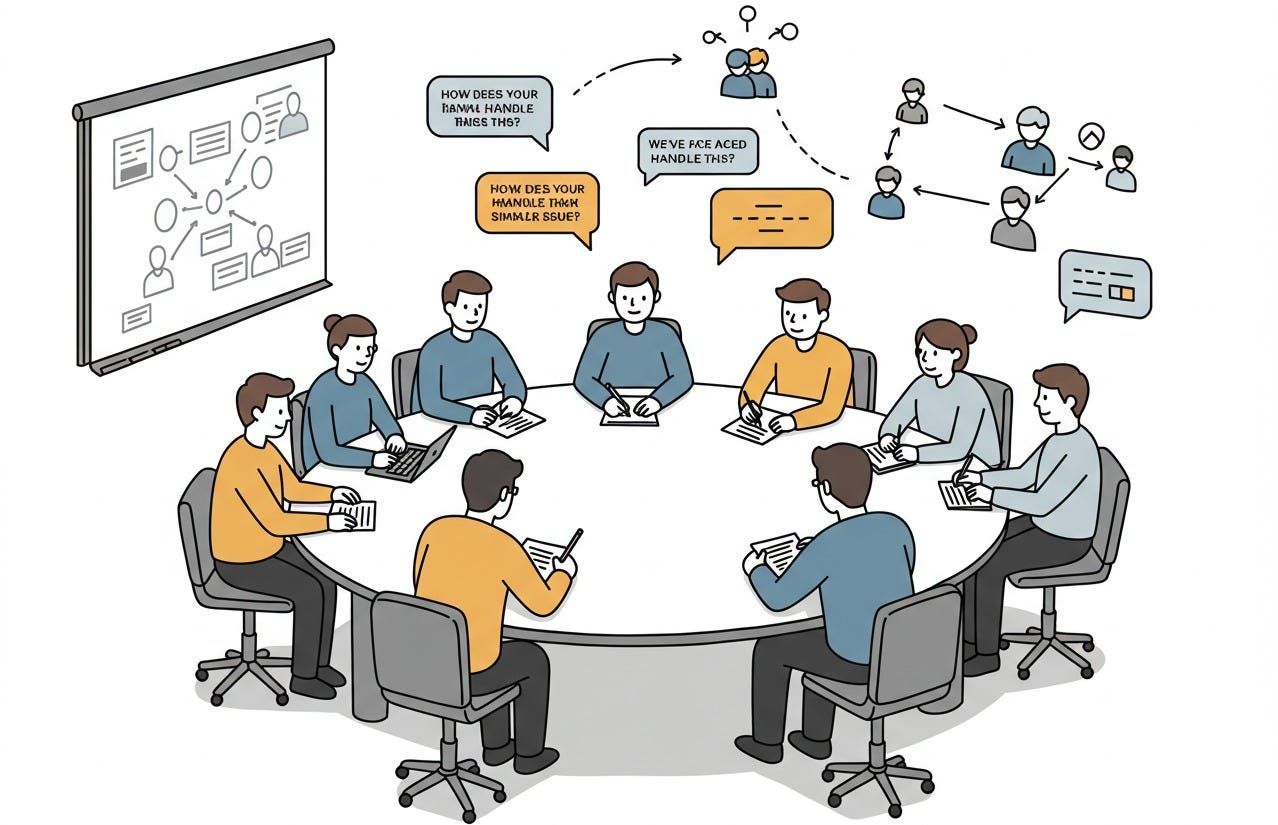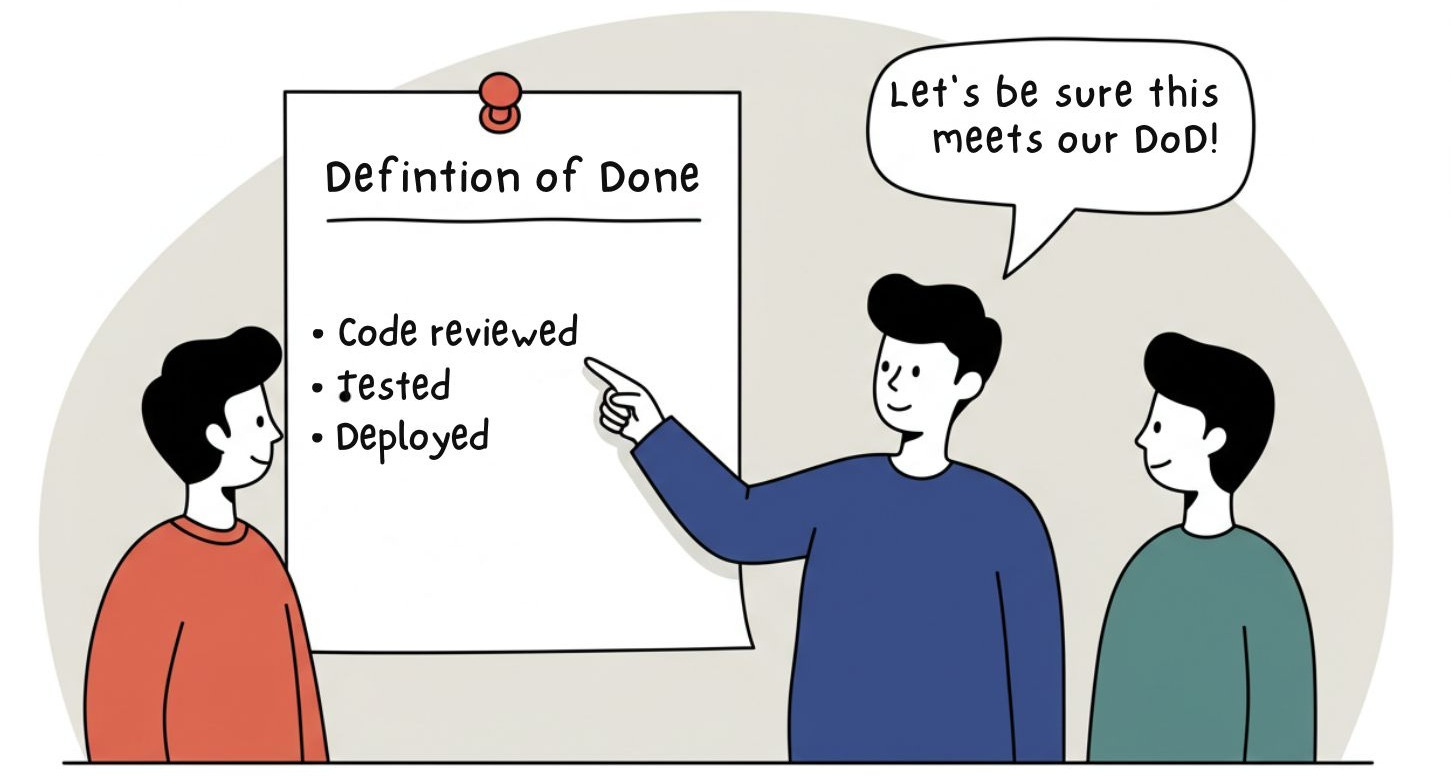Welcome to the 🔥 free edition 🔥 of Winning Strategy: a newsletter focused on enhancing product, process, team, and career performance. This newsletter shares insights gained from real-world experiences that I gathered working at Twitter, Amazon, and now as an Executive Product Coach at one of North America's largest banks. If you’d like to become a paid member, see the benefits here, and feel free to use this expense template to ask your manager.
Let me tell you the truth about Scrum Masters that nobody wants to admit.
Most Scrum Masters are “Reactive.”
Now, what do I mean by that?
They wait for problems to emerge. They wait for team members to ask for help. They think their job is to facilitate meetings and update charts.
But the best Scrum Masters? They operate differently.
They anticipate needs before they're expressed. They don't just solve problems—they prevent them from occurring in the first place.
They are “Proactive.”
The question now arises:
How do you stay ahead of problems when you're already busy managing daily team activities?
If you don't get ahead of issues, you'll always be reactive
If you try to do too much, you might burn out
This puts you in a tough spot.
Over the years, I have compiled a list of several activities that I observed successful leaders engage in to be proactive. 12 of these pertain to the role of a Scrum Master.
Myth:
As a “Proactive” Scrum Master, you do more things.
Reality:
As a “Proactive” Scrum Master, you do the same things “differently.”
After working with so many different Scrum Masters at all levels, I’ve noticed that the best ones aren't working longer hours. They're just more intentional about what they do during those hours.
In this post, I'll share 11 specific activities that transform “Reactive” Scrum Masters into “Proactive” leaders.
No theory.
No fluff.
These are practical, proven activities you can start using tomorrow.
Let’s get started.
If you’re new, here’s what you missed in the last few weeks
How Agile Metrics are Getting Misused - And How Can You Fix It?
How Do I Gather Requirements When Customer Doesn't Know What They Need?
#1 — Summary and Confirmation
This is where many Scrum Masters drop the ball.
They think their job is done when the meeting ends.
No!
Your job is to create clarity.
Meetings don’t create clarity. Summaries of the meetings do.
It’s easy for people to misinterpret what was discussed in the meetings and events, and it’s even easier for action items to slip through the cracks.
As a proactive Scrum Master, you don’t let that happen.
At the end of every meeting (or event), take two steps:
Summarize the key points discussed
highlight decisions made and why they matter
call out any blockers or risks uncovered during the conversation
keep it concise — nobody needs a second meeting at the end of the first one
Confirm action items
Who is doing what?
What are the deadlines?
Are there any dependencies or follow-ups needed?
When everyone leaves the meeting with the same understanding, you avoid confusion, rework, and wasted time.
Here’s how you do it:
set a timer for 5 minutes before the scheduled end time
say, "Let me summarize what we've discussed and agreed upon..."
list the key decisions made
clearly state each action item with an owner and deadline
ask explicitly: "Does anyone understand anything differently?"
No confusion. No missed tasks. No wasted time.
Red Flag to Watch:
If you can't summarize the key points of a meeting in 3 minutes, that's a signal that your meeting might have been unfocused. Use this as feedback to improve your facilitation skills.
Start doing this today, and you’ll immediately notice the difference.
#2 - Following up
You have captured the “action items.”
That’s a great first step, but that’s not it.
Action items don’t complete themselves.
People get busy. Priorities shift. Tasks are forgotten.
As a proactive Scrum Master, you don’t leave action items floating in the void. You “follow up.”
Following up IS NOT micromanaging. It’s ensuring progress and removing blockers.
Here’s how to do it effectively:
Check progress at the right time:
not too early because that feels like micromanaging and creates resistance
not too late because then you're just fighting fires and managing crises
just right, when you can still make a difference and provide meaningful support
Keep it casual and supportive:
Have quick hallway conversations like "Hey Tim, how's that documentation update going? Need any help?"
Drop friendly messages checking if there are any blockers you can help remove
Make it easy for team members to ask for help without feeling pressured
The goal IS NOT to create stress around action items. The goal is to ensure everyone has what they need to succeed.
For example:
When something is due on Friday, a quick check-in on Wednesday morning gives you enough time to help if needed.
Not being proactive:
Let’s say a team member is responsible for identifying a dependency with an external team, but they’re stuck waiting on an email response. Days go by, and now your Sprint is at risk.
Being proactive:
You check in 3 business days after the meeting. The team member says, “I’m still waiting on a response.” You step in, escalate the issue, and get a resolution within an hour.
Red Flag to Watch:
If you find yourself constantly chasing the same people for updates, ask:
Are the action items unclear?
Are the deadlines unrealistic?
Does this person need additional support or training?
If team members appear defensive or uncomfortable during your follow-ups, you might be coming across more as policing than as supporting. Take a step back and adjust your approach.
Follow-up strategy:
One strategy that has worked for me is to "schedule follow-ups.”
Everyone on the team understands that an action item requires a follow-up within a specific timeframe (between 3-5 days). Work together as a team to agree upon this timeframe and incorporate it into your working agreement.
Following up is about building trust. Your team must know you’re there to help, not to nag.
#3 — Maintain working agreements
Most teams create working agreements at the start.
And then?
They forget about them.
The document gets tucked away in some folder, never to be seen again.
This….should not happen.
Working agreements are living documents.
They reflect how the team works together and what they value. As the team evolves, so should the agreements.
As a proactive Scrum Master, you don’t just help your team create working agreements — you maintain and update them.
Here’s how you can ensure working agreements stay relevant:
Review them regularly.
set a reminder to review working agreements at least once per quarter—more often if the team is new or going through changes
use Sprint Retrospectives as a natural time to revisit them
Watch for signals that updates are needed.
meetings consistently running over time
team communication off the track
team members are unclear about expectations
new team members joining or leaving
recurring conflicts
changes in team structure
Updates as a team.
ask your team: “What’s working (and what’s not) in how we collaborate?
Encourage everyone to suggest changes
Keep it visible.
post them somewhere visible — like a Confluence page or a team Slack so they stay on top of mind
always send a copy of agreements as part of the agenda
Example:
Let’s say your team has a working agreement about starting Daily Scrum at 10:00 AM sharp, but half the team is consistently late.
Instead of ignoring it, you bring it up in the Retrospective:
"Hey, I noticed we’re struggling to start on time. Does 10:00 AM still work for everyone? Should we adjust the time or find another solution?"
Don’t force everyone to come on time. Adjust.
Red Flag to Watch:
If working agreements are ignored, ask yourself:
are they too vague?
do they reflect how the team actually works?
did the team have a say in creating or updating them?
Working agreements are not the rules. They're tools to help your team work better together.
#4 — Conduct regular training
Many Scrum Masters assume training is a one-time thing.
Big mistake.
Teams don’t grow by accident.
They grow through continuous learning.
As a proactive Scrum Master, you don’t wait for someone to ask for training. You take the lead in identifying gaps and opportunities to help the team level up.
Here’s how to be proactive with team trainings:
Identify learning needs.
are team members struggling with story slicing?
is there confusion about Velocity or capacity planning?
do they need a deeper understanding of Scrum values or Agile principles?
pay attention to Retrospectives, Sprint Reviews, and everyday conversations. These are goldmines for uncovering gaps
Keep them short and practical.
nobody wants to sit through a 3-hour lecture.
focus on bite-sized topics that can be applied immediately, like “How to write better user stories” or “Tips for effective backlog refinement.”
Mix it up.
you don’t have to deliver every session yourself
bring in experts, share online resources, or host lunch and learn where the team learns together
Make it a habit.
schedule training sessions at regular intervals — maybe once per Sprint or once a month.
treat it like any other team activity that adds value
Learning is never “done.”
Read the post below to get ideas on scheduling a year’s worth of training sessions:
1-Year Training Plan for Scrum and Agile Teams + Template
Red Flag to Watch
If your training sessions have low engagement or attendance, you're either picking the wrong topics or delivering them at the wrong time. Adjust based on team feedback.
Training IS NOT about teaching for the sake of teaching. It’s about solving real problems.
#5 —
Monitor team metrics
Metrics are powerful — but ONLY IF you use them the right way.
Most Scrum Masters either ignore team metrics altogether or obsess over them without understanding their purpose.
Reactive Scrum Masters track metrics because "it's required."
Proactive Scrum Masters use metrics to “spot patterns” before problems occur.
The simple activity:
Regularly analyze key team metrics to uncover hidden truths about how work flows.
Focus on just a few meaningful metrics (whatever they are):
Velocity trends (stability vs. volatility)
Cycle time (where work gets stuck)
Quality indicators (bugs, technical debt)
Sprint burndown patterns
etc.
The power is in the conversation, not the collection:
Review “trends” weekly, not just current numbers
Example: Is velocity consistently increasing? Is cycle Time gradually decreasing?
Ask "why" multiple times when you spot irregularities
Bring observations to the team as questions
“I noticed our Cycle Time has been increasing. Are we facing new blockers?”
“Our Velocity has been consistent for three Sprints — great job! Is there anything we can do to sustain this?”
Turn data into action.
For example:
Let’s say your team’s Sprint Burndown consistently shows a sharp drop in completed user stories during the last two days of the Sprint.
Instead of ignoring it, you bring it up in the Retrospective:
“I noticed we tend to finish a lot of work right before the Sprint ends. Is this a sign we’re not breaking down tasks enough or overcommitting?”
This opens the door to solutions like better backlog refinement or reducing Sprint's scope.
Red Flag to Watch:
If you collect metrics that never drive action, you're just creating busy work. Every metric should answer a question that matters to your team.
Good metrics start conversations. Great metrics inspire action.
#6 — Create an impediment board
Most Scrum Masters keep impediments in their head. That's like trying to juggle blindfolded — eventually, something important will drop.
An impediment board makes blockers visible, trackable, and, most importantly, resolvable.
Set Up Your Impediment Board
Option #1 — If the impediments impact the ongoing work, it is preferable to include them on the Scrum Sprint board as user stories.
Option #2 — If the impediments are well recognized and may require more time than the sprint's duration, it is advisable to keep them on a separate Kanban board.
Keep the Kanban Board simple:
Basic Columns:
Identified
In Progress
Waiting External
Resolved
Parked (for items that can't be resolved now)
Track the following for each impediment:
Description of the impediment
Impact level
Date identified
Owner
Next action
Target resolution date
Learn more about how to manage impediments in the posts below:
For example:
Let’s say your team is blocked because they’re waiting on access to an external API. The request has been stuck in approval for over a week.
Instead of letting the team struggle, you:
Log the issue on the Impediment Board
Follow up with the responsible person daily
Escalate to leadership if necessary
An impediment board is only as effective as the actions it drives.
#7 — Network with other Scrum Masters
Scrum Masters don’t work in a bubble.
Your team operates within a larger ecosystem of other teams, departments, and stakeholders. And often, cross-team dependencies become the biggest blockers to progress.
As a Scrum Master, building strong relationships with other Scrum Masters and departments is important.
It helps you identify and resolve these dependencies early.
How to do it:
Connect regularly with other Scrum Masters
Set up check-ins to share updates, discuss overlaps, and align on priorities
Join an existing Community of Practice
Spot dependencies early
During backlog refinement, ask: “Do we need anything from another team or department?”
Proactively reach out those teams (Scrum Masters) and align timelines
Facilitate cross-team conversations
Don’t wait. Act as a bridge between teams to clarify needs and resolve conflicts
Escalate when needed
If a dependency is beyond your control, escalate with clear data and proposed solutions
Suggestion:
Strong relationships are built “before” they're needed.
Invest time building and maintaining these connections even when there aren't immediate problems to solve.
#8 — Conduct pre-refinement sessions
Refinement sessions often waste valuable developer time on unprepared stories.
As a proactive Scrum Master, you can help the Product Owner by conducting pre-refinement sessions to ensure stories are clear, prioritized, and actionable before they’re presented to the team.
How to Run Pre-Refinement Sessions:
meet with the Product Owner for 30-60 minutes weekly
review stories planned for the next team refinement
check for clear acceptance criteria, business value, and dependencies
identify which stories need more work before team review
For example:
Start with the story's core – its business value.
Help your Product Owner articulate why this story matters and how it benefits users. This foundation guides all other refinement decisions.
Next, examine the story structure. Is it too large? Does it hide multiple stories within? Break down epics into digestible pieces that the team can estimate and deliver within a sprint.
Then focus on clarity. Each story needs:
A clear, specific goal
Well-defined acceptance criteria
Documented assumptions and constraints
Identified dependencies and risks
Supporting materials (mockups, workflows, technical specs)
Note: Your goal isn't perfection – it's preparation. Create enough clarity to enable productive team discussions while leaving space for the team to shape the implementation approach.
#9 - Casually reinforce Agile values
Agile is a “mindset.” We all know that.
As a Scrum Master, one of the most impactful things you can do is casually reinforce Agile values in everyday conversations.
These subtle reminders help the team internalize Agile principles without feeling like they’re being “taught.”
For example:
When you see the team demonstrating Agile values, call it out in a natural way:
“That’s a great example of collaboration!”
“I love how we’re responding to change instead of sticking rigidly to the plan.”
When helping the team make decisions, frame it through the lens of Agile:
“Since our highest priority is delivering value, what’s the smallest increment we can deliver?”
“Let’s prioritize working software over detailed documentation here.”
Use phrases from the Agile Manifesto or principles to normalize them in conversation:
“How can we get fast feedback on this?”
“Let’s focus on simplicity — the art of maximizing the amount of work not done.”
Let’s say during a Daily Scrum, a team member mentions they pivoted to address a new customer need.
You casually say, “That’s a perfect example of responding to change over following a plan — awesome!”
Keep it informal and avoid sounding preachy. The goal is to make Agile values feel natural, not forced.
#10 — Periodically remind DoD
The DoD is more than just a checklist. It’s a commitment to quality.
But over time, teams can lose sight of it.
As a proactive Scrum Master, it’s your job to remind the team of their DoD and ensure it remains central to how they deliver work.
Here’s how:
Choose natural moments to bring attention to the DoD:
Bring it up during events:
In Sprint Planning: "Before we take on these stories, let's remember what 'Done' means for us. Are we confident we can complete everything on our checklist for each of these items?"
During Daily Scrums: When someone's about to complete a task, gently ask, "How are we tracking against our Done criteria for this one?"
During Refinement: "As we size this story, let's remember everything that needs to happen to call it truly Done."
Other opportunities to remind DoD:
when a team member is about to mark something complete
during the final days of a sprint when finishing touches matter
when discussing acceptance criteria for new stories
after incidents that might suggest a DoD gap
Red Flag to Watch:
If the team consistently misses parts of the DoD, ask yourself:
Is the DoD realistic and achievable?
Does the team understand the importance of the DoD?
By periodically reinforcing the Definition of Done, you help the team maintain a high standard of quality and deliver “consistent” value.
#11 — Celebrate sprint completion
Celebrations matter, even small ones.
Marking the end of each sprint with a moment of acknowledgment helps create positive associations with sprint completion.
Keep it light and quick
End each sprint with a brief celebration that fits your team's culture:
Option #1: Share a quick summary:
"Great sprint, everyone! We completed 8 stories, resolved 3 bugs, and delivered feature X!”
Option #2: Post a relevant GIF:
Choose something that matches the sprint's theme or inside jokes. Maybe it's a:
“victory dance” for hitting all goals, or a
“tired-but-proud” reaction for a challenging sprint
Make it meaningful
Vary your approach based on the sprint's character:
For achievement-filled sprints:
highlight specific wins and their impact
share positive customer feedback
note team members who went above and beyond
For challenging sprints:
acknowledge the hard work
highlight lessons learned
express confidence in the team's resilience
You don’t need an elaborate ceremony.
A quick moment to pause, acknowledge the work, and transition positively into the next sprint is sufficient.
🎁 Notion Template: Proactive Scrum Master
I've developed a Notion template to help you implement what you've learned. This template allows you to systematically incorporate actionable steps into your daily routine, helping you create a proactive mindset.
You can download the template here: 🎁 Proactive Scrum Master Template
In Closing
A Proactive Scrum Master shapes culture through small, consistent actions rather than grand gestures.
These 11 micro-interventions require minimal time but yield compounding benefits.
Keep in mind: Your presence matters more than your presentations. Your questions create more change than your answers.
Start with just one of the above this week. Notice what happens. Add another next week.
You don’t have to know everything. You just do the right small things consistently.
Show your support
Every post on Winning Strategy takes 3 days of research and 1 full day of writing. You can show your support with small gestures.
Liked this post? Make sure to 💙 click the like button.
Feedback or addition? Make sure to 💬 comment.
Know someone who would find this helpful? Make sure to recommend it.
I strongly recommend that you download and use the Substack app. This will allow you to access our community chat, where you can get your questions answered and your doubts cleared promptly.
Further Reading
Connect With Me
Winning Strategy provides insights from my experiences at Twitter, Amazon, and my current role as an Executive Product Coach at one of North America's largest banks.

















Excellent Vibhor!
Just wanted to say thanks for the amazing content! Each post is a treasure trove of knowledge. (I’ve learnt something new today.. Notion!!) 😊
Your passion shines through in every piece, and I'm constantly impressed by it.
Thanks for sharing your expertise and inspiring others!
Thank you Kameswari.